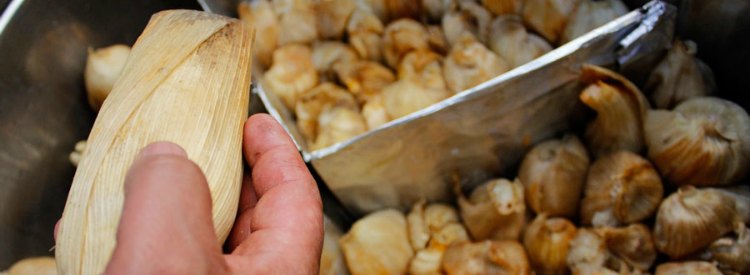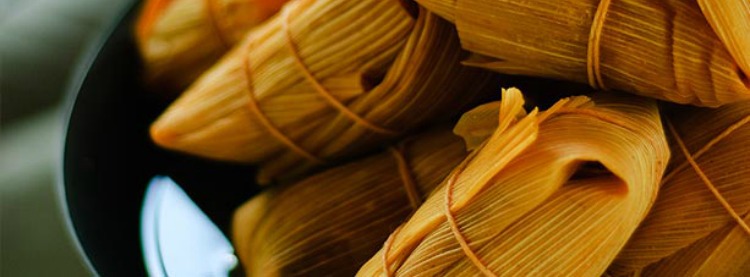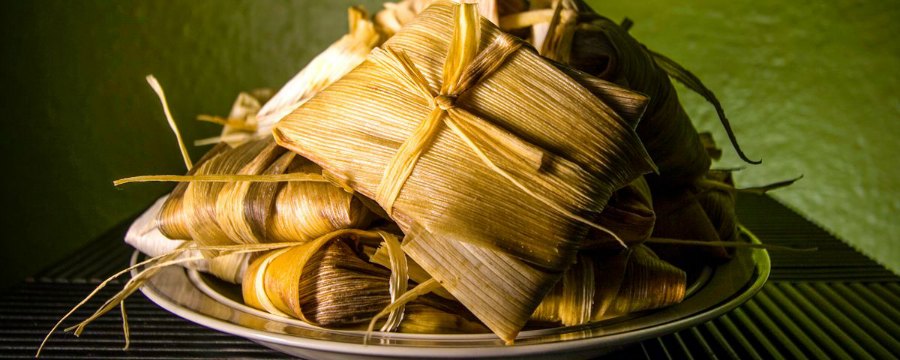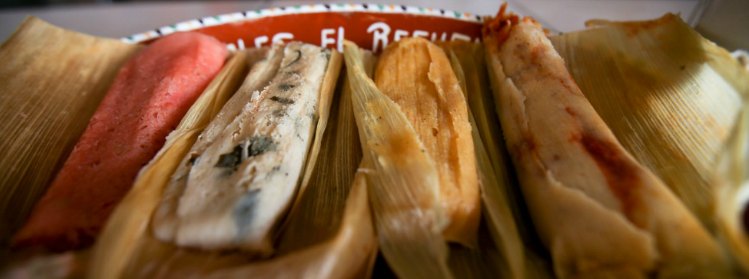Traced back to as early as 1200BC in the Gulf region of Mexico, this common Mexican dish is made in homes all over Mexico. And get this, there are between 600-1000 different varieties of tamales. This culinary tradition has also spread all over Central and South America with great recipes found in Columbia, Venezuela, Peru and more!
The word Tamal comes from Nahuatl, one of Mexico’s ancient living languages. The Nahuatl word tamalli means wrapped.
Let’s Make Tamales!

First we need to prepare the batter.
The corn needs to be selected and in Mexico it could be white, yellow, pink, blue, black, purple…
The grain needs to be cooked with a specific technique, nixtamalization. This process is where corn is boiled with lime stone dissolved in water for a short period. How long the corn is boiled will depend on the corn variety. The boiled corn needs to rest overnight and in the morning is washed well to remove the excess lime stone. This process gives the kernels elasticity and increases the mineral content, specifically vitamin B3, which prevents a disease called pellagra (a skin infection).
Once nixtamalization has been completed, the corn kernels need to be ground with a volcanic stone grinder. The texture will depend on the type of tamal we want to make. For example, Zacahuil tamales require a coarsely ground corn kernels where as tamales from Oaxaca require a finely ground corn kernel.
The corn masa – corn dough – is made by adding water or broth (chicken, pork, vegetables, turkey, beef, venison, etc.) and lard, oil, butter to the ground corn. At this step the tamale maker decides how thick or runny the batter will be.
The dough is placed aside as we prepare the tamale filling. Fillings vary from family to family and region to region but could be: green salsa, red salsa, mole (green, red, chocolate, yellow, black, white, pink…), fruits like pineapple jelly or blackberry jam or just vegetables which is added to a protein. Proteins are determined by regional availability. Insects, dry meat, snake, fish, lobster, octopus, other kind of seafood, chicken, pork, beef, turkey, venison, iguana, beans, cheese are some of the protein options found in Mexico.
With the dough and filling prepared, the final stage is determining not only what to wrap your tamale with but also in which shape! Shapes range from triangular, square, rectangular, long, short or spherical. Wrapping materials can be banana leaf, corn husk, some agave, palm tree, fern, aromatic herbs? Finally, the tamale is cooked and again there are many choices; boiled, steamed, grilled, baked in the ground or in a clay oven.
So really a common dish but not that simple at all.

Let’s Have a Party! In Mexico that Translates to Time to Make Tamales!
Mexican families get together to cook tamales on special occasions. It is true that we can find tamales sold daily at a corner stand but when a family decides to make them together, it is serious business! The kitchen needs to be prepared, the pot to boil the tamales is put out. Tamale posts are past down through generations as a heritage piece, coming from your mom or your grandmother. The female team gathers – every daughter, sister, aunt, cousin, niece, mother and of course the eldest female, be it a grandmother or great grandma leads the team.
The flavors, shape, wrapping and cooking method have been decided by the elder, the tasks are delegated to the family members. One of the first steps is to be sure that no one in the kitchen is pregnant. The legend states that if a pregnant mother makes the tamales, their unborn child will ensure the tamales won’t cook. Pregnant moms are responsible to make the corn masa only, and then bless the ground oven once the tamales are ready to be cooked. This blessing has the pregnant women covering the tamales in the ground oven by jumping on the top layer of dirt as she makes the sign of the cross. Though this tradition is not common in this day and age, I have witnessed this legendary process and found it fascinating.
The cooking process for the tamales is crucial, which is why rituals are as important as the recipe. One ritual is the proper closing of the steamer. The handles of the pot are thought to resemble ‘ears’. Our grandmothers say that in the kitchen usually “women get gossipy”, even the steamer, which is considered a female device! So, they tie well the ears of the steamer so it doesn’t hear the gossip going around and then it can focus just on cooking the tamales.
Other rituals include putting dried chiles or the pestle of the molcajete (mortar) inside the steamer, traditions that seem to ensure your tamales will cook well.
Also, you can put a guardian tamal in the steamer before you close it, yes! This tamal is made with all the left overs of masa, salsa, meat or all the ingredients used in the tamales making process, this tamal is usually very big and is put on the top and acts like a monitor, checking that all the tamales cook properly and on time!
All these traditions are part of Mexico’s intangible cultural heritage and preserves our culinary culture for many generations to come.
Día de la Candelaria, February 2nd – Tamales Day in Mexico
The Catholic influence in Mexico seeps into every aspect of our society. Candelaria Day is celebrated on February 2nd but the tradition starts at Christmas. Mexican families put a nativity scene in their home to commemorate the birth of Jesus Christ. On January 6th, there is a specific cake, Rosca de Reyes, a tradition to remind families when the three kings gave three presents to baby Jesus. Inside the cake is a little figurine of baby Jesus (ceramic or plastic) and if someone receives the figure in their piece of cake, this person becomes the ‘Godfather’ of the baby Jesus. This means that this person will make or pay for the tamales to celebrate baby Jesus Christ’s birth on Día de Candelaria.
But why tamales? It is leftover from pre-Hispanic times when pre-Hispanic gods were honored with tamales. Tamales were important in that period because it was a bread made with corn and corn was the flesh that the gods decided to use to give form to humans. Tamales were a sacred dish, thats why nowadays, to celebrate catholic holidays, tamales are the first on the table. In this way, Candelaria day brought a synchronicity so that all Mexicans wait with joy and an empty stomach to taste as many as possible and of course with great expectations of the flavors and the variety of tamales presented.

Now you know more about this influential Mexican dish, the next time you taste it, please consider it as a piece of history, you are tasting history! And please do not forget to celebrate Candelaria day by making your own tamales and sharing them with all the ones you love or share with us in www.rivieramayafoodtours.com/tours



Comments